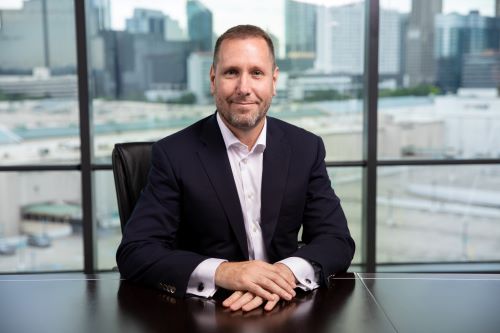

If it isn’t yet clear that innovation is a key strategy for many insurance companies, and lies at the center of their plans to stay competitive and meet their customers’ evolving needs, A.M. Best has brought this point home even more. The global ratings agency has underscored insurers’ ability to innovate as an increasingly important indicator of long-term financial strength via its ongoing initiative to include this element as part of its rating methodology.
In September, A.M. Best released an updated draft of its new criteria procedure, “Scoring and Assessing Innovation,” after kicking off the process last year when it surveyed over 450 insurance groups in 48 countries to gauge what innovation means to them.
“The overwhelming response was that innovation, they felt, was critical to the success of their businesses,” explained Stefan Holzberger (pictured above), chief rating officer at A.M. Best. “We took that information and developed a rating criteria on assessing company’s innovation, and that was released for public comment earlier this year. We’ve [since] received a whole bunch of feedback from the market – insurance companies, brokers, regulators, government agencies – on the draft criteria, took that on board, and, this fall, we released the criteria for a second round of public comment. We expect for the assessment of innovation to be officially part of our global rating methodology for assessing insurance companies’ financial strength in the first half of next year.”
Including innovation in the rating methodology was especially important to do now because of significant societal shifts that are currently underway. These include the growth of the gig economy, changing consumer trends and patterns, as well as evolutions in technology and the impacts of climate change coming home to roost for property and casualty insurers.
“The whole landscape is changing and we feel that if an insurance company isn’t innovative and doesn’t really have its finger on the pulse with all these changes, they are going to be subject possibly to adverse selection [and] loss of relevance if they don’t keep up with this rapid pace of change,” said Holzberger.
The insurance industry hasn’t always been the fastest adopter of change, though A.M. Best noted in its draft criteria that “many insurers have historically found nimble ways to adapt to an ever-changing market environment without having to become sophisticated technology players.” Nonetheless, companies in the sector are facing a 100-mile-an-hour wind at their sails, said Holzberger.
“There are so many possible solutions out there that have implications for the insurance industry. It’s not something where the insurance industry by any stretch can just be blind to what’s going on out in the market with some of these innovative solutions. They need to be willing to open up their business and think in an innovative way, ‘how can I leverage some of these capabilities and cut my costs, improve my customer experience, and grow the business,’” he told Insurance Business. “The way we look at innovation, we very purposefully don’t look at it just from the lens of the insurance industry because disruption and competition can very well come from outside of the industry. So, as we do the assessment of innovation, we want to make it clear to our client base that you’re not just being judged on where the insurance industry is, in terms of leveraging technology and being innovative. We’re really looking on an absolute basis across the whole business environment to say, where are you as a company in relation to the capabilities that are out there?”
Many companies in the insurance industry are ready to meet this change head on, according to a leader who recently joined the ranks of an insurance technology giant.
“The pace of [change] is hard to predict because it is a fragmented industry,” said Taylor Rhodes (pictured below), Applied Systems’ new CEO who joined the company in June. “But, I think it’s probably inevitable to say that the benefits of technology will start to permeate, both on the agency and the insurer side.”

He added, “I feel like I’m joining this industry at a time when the pace of change is really starting to pick up and we’re validating that through lots of conversations with our customers.”
Rhodes also pointed to recent reports that insurtech investments this year are booming – in fact, they are already exceeding 2018’s totals. Rhodes’ job at Applied is to help the company navigate through this rapid pace of change and innovate from a position of strength, with 50% of all P&C electronic transactions today already occurring within Applied applications.
“We also know that companies who get smug get beaten eventually, and so I like to talk about a healthy level of sense – of ‘let’s be the place where insurtech happens, let’s not be the place that insurtech happens to,’” said Rhodes.
With consolidation continuing in the agency space, Applied also aims to help consolidators be prepared for a seamless integration post-M&A.
“How do we help them use technology to actually get the scale that they’re looking for in buying that business? We’ll talk a lot about that with the market going forward,” explained Rhodes. “We think another thing along the lines of personal lines and simple things going more direct is [where is that] growth going to come from, and I think you don’t have to be a brain surgeon to think, well, it’s more complex commercial lines and its employee benefits. So, becoming a composite agency and not just a P&C agency is another source for growth.”
Meanwhile, the ratings agency recognizes that smaller companies might not be able to innovate at the scale of larger players in the market.
When assessing companies’ innovative inputs, “It doesn’t have to be investments in technology – it could just be a change in process, because some of the small companies might not have the resources to do huge technological improvements, but they can definitely do some process improvements and also maybe partner with a third party,” said Greg Williams (pictured below), senior director at A.M. Best.
While A.M. Best’s innovation-injected rating methodology will not be so significantly different as to change companies’ current ratings, the team echoes Rhodes’ sentiments that change in the insurance marketplace isn’t going to stop and there’s a need to adapt or risk withering away.
“There’s no expectation that it’s going to slow down, so it’s more and more likely that for companies that do not have an innovative culture, that they’ll fall behind, that their profile in the market will diminish, and the competition will deliver a better customer experience,” said Holzberger.
